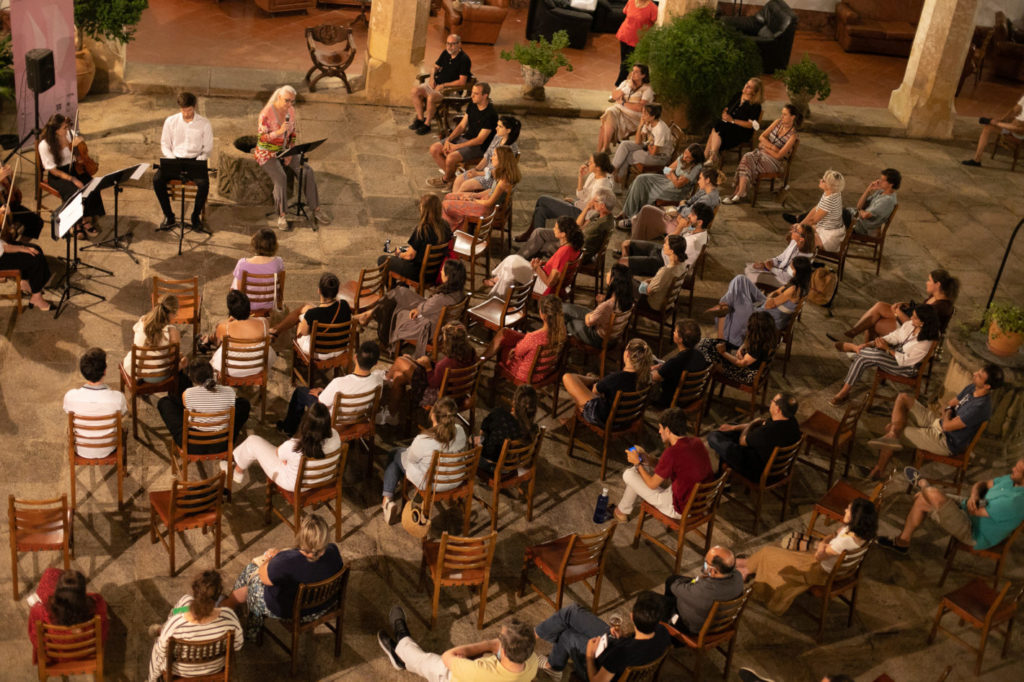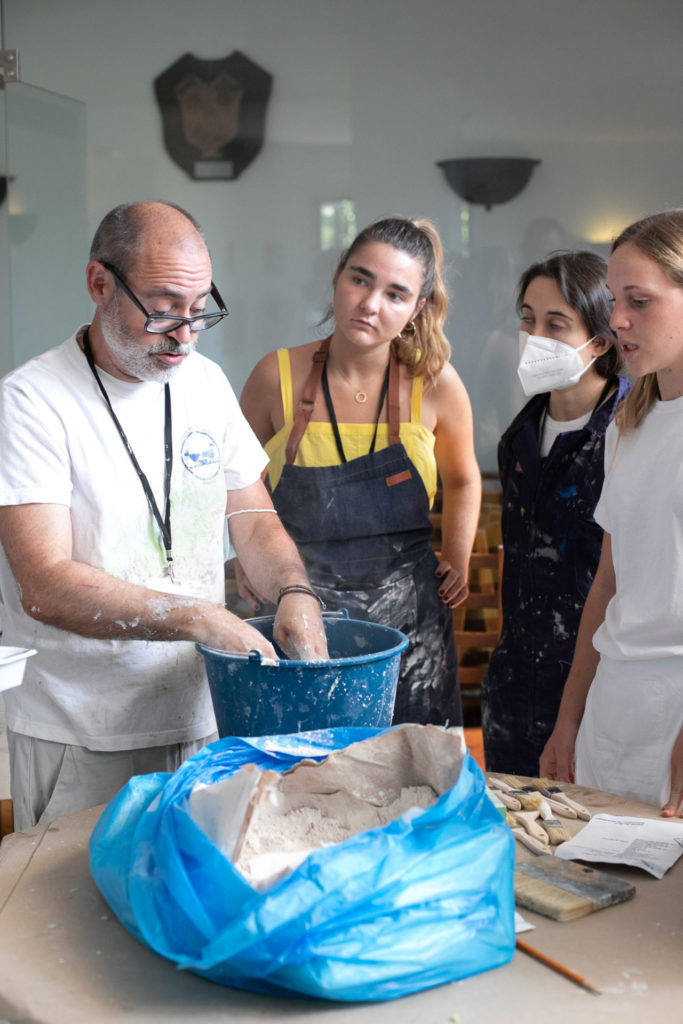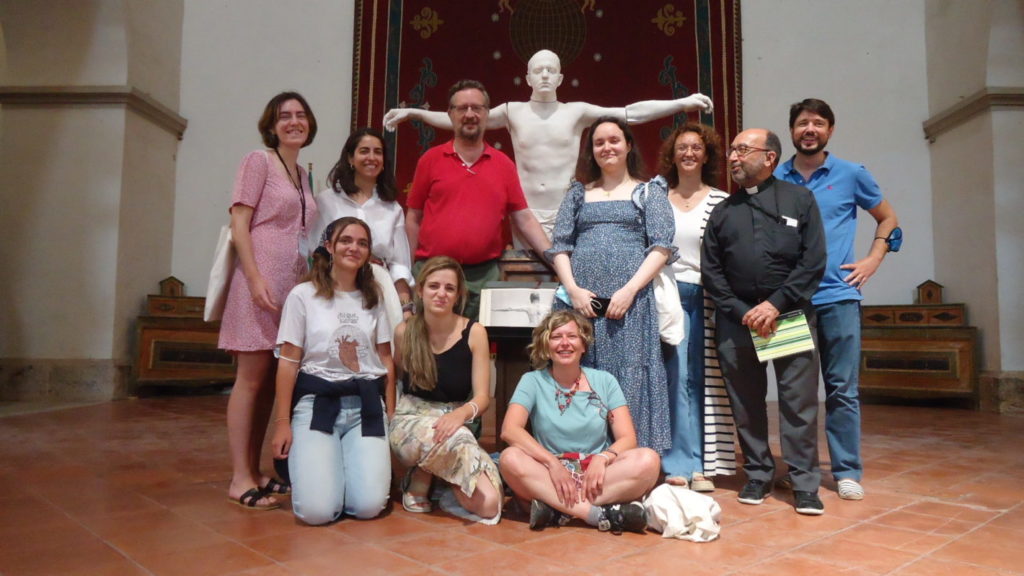The Word was made flesh and dwelt among us (Jn 1:14). In the monastery of Guadalupe, God's action has become a loose brushstroke, a trapped image, a free verse, an imprint in the clay, a living expression, a liberating melody... The Observatory of the Invisible has managed in its first edition to make the invisible visible thanks to the participation of almost a hundred university students and artists, young and not so young. A hundred people in search, who gathered in this enclave, to observe where, a priori, nothing is seen and express what was revealed before their eyes.
The initiative promoted by the Via del Arte Foundation (made up of a Board of Trustees with a recognized trajectory in different artistic disciplines) organized in this place of pilgrimage, between July 26 and 31, a summer course with various workshops in photography, writing, painting, music, sculpture and ceramics where to immerse oneself in an artistic project in which art and spirituality went hand in hand. There were five hours a day in which the participants, guided by the teachers, created an artistic project, whether it was finding God in verses, capturing him in an image, in the sculpture of a young man with outstretched arms, the rehearsal of a requiem, painting on canvas, making clay pieces or learning the connection between the body and words.

The workshops were led by the actress Yolanda Ulloa, the sculptor Javier Viver, the musician Ignacio Yepes, the painter Santiago Idáñez, the ceramist Juan Mazuchelli, the photographer Lupe de la Vallina and the philologist Antonio Barnés. The master classes were given in the incomparable setting of the Monastery-Fortress of Guadalupe with its venerated image of the Virgin, its paintings by Zurbarán or El Greco, its collection of illuminated illuminated codices and cantorales, liturgical books and sacred ornaments that made the tasks that were undertaken even more inspiring.
In times of pandemic and virtuality it was fantastic to see that a hundred lives with different interests, concerns and experiences mixed with art using their words, their hands, their arms and their feet without the mediation of screens or cell phones to create and bear fruit: the result of their search for the invisible. The initiative has had the support of several universities such as San Pablo CEU, Internacional de la Rioja, Francisco de Vitoria, Navarra, Comillas and Nebrija (as well as the Ángel Herrera Oria Foundation, the Nártex Association, the Art and Faith Association and the Roots of Europe Association), which have provided scholarships to a large group of their students and have offered the participants meetings with Church personalities such as the Archbishop of Toledo, Francisco Cerro, to whose diocese the Monastery belongs; and the famous painter and sculptor Antonio López.
The Franciscan friars have been exceptional hosts for the Observatory. They have opened their home to the students and the organization. Their father guardian has guided them on various visits throughout the premises to show them the artistic riches they treasure. They even placed the organ and choir at the Observatory's disposal, a privilege well taken advantage of by Celia Sáiz, a student who gave the group, seated in the choir of the basilica, an unforgettable concert.

The participants were accommodated in the Hospedería del Monasterio, built around a beautiful and well-preserved Gothic cloister, inspiring and welcoming at the same time, where the stone was a symbol of the fusion between art and spirituality. A cloister that has been both a meeting place, a place for coffee and lively conversations and also a stage to show the work of the workshops. They have also been able to attend mass in the basilica every morning, crossing the Mudejar cloister, a beautiful place where the scent of roses and lilacs was a gift for the senses. In addition, they have had a corner of prayer and recollection to pray every afternoon next to a beautiful carving of the Virgin, by Javier Viver, through polyphonic songs.
As the days went by, teachers y disciples They were put in relation in a natural way in the different spaces, both formal and informal: forums to share projects and in which new collaborations were also sought for them, through getting to know the people with whom the table was shared or in the cloister of the Hospedería itself: there you could feel the relaxed and friendly atmosphere where new synergies were generated, where visions on artistic creation were put in common, where gifts were shared. And in this breeding ground, interdisciplinary collaborations arose, which were shown every night in the literary, musical, photographic evenings... In these spaces everything was put in common and the legacy of this first Observatory of the Invisible was interwoven.
As a sample of what happened there, we transcribe a poem that was born in the writing workshop, which contains the essence of what was lived there, because what is not seen... will be what lasts.
To observe the invisible
five senses are not enough
we need it to vibrate
the body attached to the soul.
We need the lens
that changes the way we look at things.
...and that light passes through us,
shakes us,
soaks us,
with a very warm silence
that redeems us
and saves us.
That turns upside down
the fees, the measures
compasses and maps.
...and that light remains on
in new and old words
in that living Hallelujah,
in piano chords
distilled from nothing,
in stained hands
of mud,
in that trapped life
at the right time,
in the stone that speaks to us,
on this huge canvas of yours
that bleeds on one side.
And that light overflows
in the gleams of other glances
that tremble, vibrate and fly
and the invisible becomes incarnate.
It was nice that, although the poem was written by Sonia Losada, it was recited by everyone in the workshop, which showed very well the team spirit that permeated all those days.
Yolanda Ulloa directed the theater workshop. For her, Observatorio de lo Invisible, "as its name indicates, is an extraordinary initiative where a space is created so that each of us can give ourselves the quality time necessary to dive into the "deep" and, through different arts, make the invisible visible".
The testimony of Luisa Ripoll, engineering student and passionate about literature, can serve to end this chronicle: "I am very grateful for the experience I have lived at the Observatory. Of all the courses and camps I have attended, there was a special atmosphere there: the human quality of all the participants was incredible, and there was always someone willing to talk quietly about any topic. There was an interest in the search for oneself, for the Other and for others. We started from a common framework: for all of us, Art is something important. In this way, through this personal artistic experience that became shared, we were able to form closer bonds. The whole monastery breathed fraternity".









